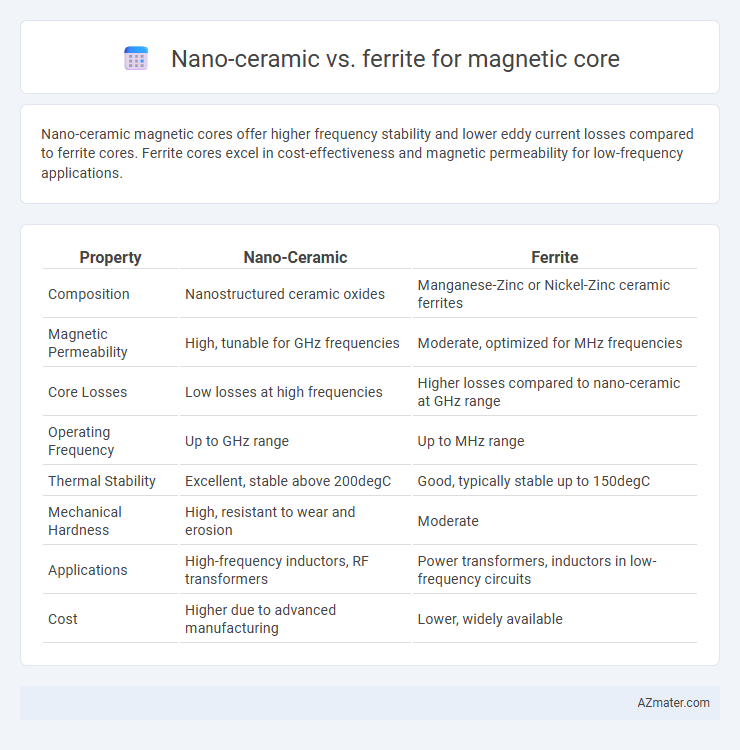Nano-ceramic magnetic cores offer higher frequency stability and lower eddy current losses compared to ferrite cores. Ferrite cores excel in cost-effectiveness and magnetic permeability for low-frequency applications.
Table of Comparison
| Property | Nano-Ceramic | Ferrite |
|---|---|---|
| Composition | Nanostructured ceramic oxides | Manganese-Zinc or Nickel-Zinc ceramic ferrites |
| Magnetic Permeability | High, tunable for GHz frequencies | Moderate, optimized for MHz frequencies |
| Core Losses | Low losses at high frequencies | Higher losses compared to nano-ceramic at GHz range |
| Operating Frequency | Up to GHz range | Up to MHz range |
| Thermal Stability | Excellent, stable above 200degC | Good, typically stable up to 150degC |
| Mechanical Hardness | High, resistant to wear and erosion | Moderate |
| Applications | High-frequency inductors, RF transformers | Power transformers, inductors in low-frequency circuits |
| Cost | Higher due to advanced manufacturing | Lower, widely available |
Introduction to Magnetic Core Materials
Nano-ceramic magnetic cores offer superior high-frequency performance and lower core losses compared to ferrite cores, making them ideal for advanced electronic applications. Ferrite cores, composed of iron oxide combined with other metal oxides, are widely used due to their high magnetic permeability and cost-effectiveness in low to medium frequency ranges. Choosing between nano-ceramic and ferrite materials depends on factors like operating frequency, thermal stability, and core losses in specific electromagnetic device designs.
What is Nano-Ceramic Magnetic Core?
Nano-ceramic magnetic cores consist of ultra-fine ceramic particles that enhance magnetic properties through improved grain boundary control and reduced eddy current losses compared to traditional materials. These cores offer superior permeability, higher saturation flux density, and excellent thermal stability, making them ideal for high-frequency applications. In contrast to ferrite cores, nano-ceramic cores provide better performance in power efficiency and signal integrity in transformers and inductors.
Understanding Ferrite Magnetic Cores
Ferrite magnetic cores, made from iron oxide combined with other metallic elements, exhibit high electrical resistivity and low eddy current losses, making them ideal for high-frequency applications such as transformers and inductors. Their magnetic permeability and low core losses enhance signal integrity in RF circuits and power electronics, contrasting with nano-ceramic cores that offer higher saturation magnetization but typically greater eddy current losses. Understanding ferrite's balanced magnetic properties and thermal stability is crucial for designing efficient magnetic components in telecommunications, power supplies, and electromagnetic interference suppression.
Key Differences: Nano-Ceramic vs Ferrite
Nano-ceramic magnetic cores offer higher saturation flux density and better thermal stability compared to ferrite cores, making them suitable for high-frequency and high-power applications. Ferrite cores exhibit lower core losses at high frequencies but have lower saturation magnetization and are more brittle. Key differences include nano-ceramic's superior magnetic permeability and temperature tolerance versus ferrite's cost-effectiveness and proven reliability in lower-frequency transformers and inductors.
Magnetic Properties Comparison
Nano-ceramic magnetic cores exhibit higher saturation magnetization and lower coercivity compared to ferrite cores, resulting in improved magnetic efficiency and reduced energy loss. The intrinsic high permeability of nano-ceramics supports better signal integrity and enhanced inductance at high frequencies, whereas ferrites typically experience increased core losses beyond MHz ranges. Nano-ceramic cores also demonstrate superior thermal stability and lower eddy current losses, making them ideal for high-frequency power applications.
Efficiency and Power Loss Analysis
Nano-ceramic magnetic cores exhibit higher efficiency compared to ferrite cores due to their superior magnetic permeability and lower core losses at high frequencies, which significantly reduce power dissipation. Ferrite cores, while cost-effective, suffer from increased hysteresis and eddy current losses when operating at higher frequencies, resulting in lower overall efficiency and higher thermal stress. Power loss analysis clearly shows nano-ceramic materials maintain minimal core losses across a broader frequency range, making them ideal for high-performance power applications demanding enhanced energy efficiency.
Temperature Stability: Nano-Ceramic vs Ferrite
Nano-ceramic magnetic cores exhibit superior temperature stability compared to ferrite cores, maintaining consistent magnetic permeability and reduced core losses at elevated temperatures above 200degC. Ferrite cores, commonly used for their low cost and good performance at room temperature, typically experience significant permeability degradation and increased losses when exposed to temperatures exceeding 125degC. Applications requiring high thermal resilience and stable magnetic properties under thermal stress benefit more from nano-ceramic cores due to their advanced material composition and microstructure.
Applications in Modern Electronics
Nano-ceramic magnetic cores exhibit higher permeability and lower hysteresis loss, making them ideal for high-frequency transformers and inductors in modern electronics such as 5G communication devices and electric vehicles. Ferrite cores offer excellent magnetic properties with cost efficiency and thermal stability, widely used in power supplies, EMI filters, and RF transformers. The choice between nano-ceramic and ferrite cores depends on the specific frequency range, power handling, and size constraints of the electronic application.
Cost and Availability Factors
Nano-ceramic magnetic cores offer high magnetic permeability and low core losses but are generally more expensive due to advanced manufacturing processes and limited suppliers. Ferrite cores provide cost-effective solutions with widespread availability and extensive use in high-frequency applications, making them the preferred choice for budget-sensitive projects. The choice between nano-ceramic and ferrite cores largely depends on balancing performance requirements with budget constraints and supply chain considerations.
Choosing the Right Core: Factors to Consider
When choosing between nano-ceramic and ferrite magnetic cores, factors such as frequency range, power loss, and temperature stability are critical. Nano-ceramic cores excel in high-frequency applications due to their low eddy current losses and superior thermal resistance, while ferrite cores offer cost-effective solutions with high magnetic permeability ideal for low to medium frequencies. Evaluating application-specific requirements like electromagnetic interference suppression, mechanical strength, and operational environment ensures optimal core material selection.

Infographic: Nano-ceramic vs Ferrite for Magnetic core
 azmater.com
azmater.com